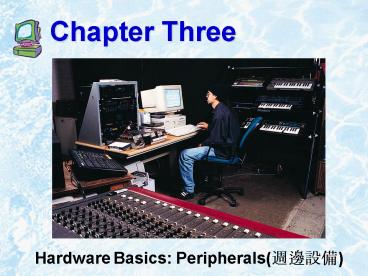Chapter Three - PowerPoint PPT Presentation
1 / 35
Title:
Chapter Three
Description:
Computer Systems: The Sum of Its Parts. 1999 Addison Wesley ... Video digitizers contain circuitry to digitize frames from camcorders and other video sources. ... – PowerPoint PPT presentation
Number of Views:47
Avg rating:3.0/5.0
Title: Chapter Three
1
Chapter Three
- Hardware Basics Peripherals(????)
2
Chapter Outline
- Input From Person to Processor
- Output From Pulses to People
- Storage Devices Input meets Output
- Computer Systems The Sum of Its Parts
3
Input From Person to Processor
Person
Processor
Input Device
4
The Omnipresent Keyboard
Do you know where these keys are located on the
keyboard and how to use them? Letters, Numbers,
Cursor Keys, Delete Key, Enter (Return) Key, and
Function Keys
5
Pointing Devices
Mouse
Touch Screen
Joystick
Graphics Tablet
Trackball
6
Reading Tools
- Optical-mark readers
- Bar-code readers
- Magnetic-ink character readers
- Wand readers
7
Digitizing the Real World
Video digitizing
Hand-held Scanner
Audio digitizing
Flatbed Scanner
8
Audio Digitizers
Audio digitizers contain circuitry to digitize
sounds from microphones and other audio devices.
9
Video Digitizers
Video digitizers contain circuitry to digitize
frames from camcorders and other video sources.
10
Scanners
Scanners capture and digitize images from
external paper sources.
11
Output From Pulses to People
Paper
Video Monitor
Sound
Controlling Other Machines
12
Digital Cameras
Digital cameras turn real-world scenes into
digital images that can be stored and manipulated
by the computer.
The images, stored in memory, can be transferred
to a computer for either editing or storage.
13
Screen Output
- Video Monitor
- Also called Video Display Terminal (VDT)
- Image exists in video memoryVRAM
- Monitor size is measured diagonally across the
screen
14
Pixels
- Images are made up ofdots called pixels
forpicture elements - The number of pixelsaffects the resolutionof
the monitor - The higher the resolution,the better the image
quality
15
Color Depth (Pixel Depth)
- The amount of information per pixel is known as
the color depth - Monochrome (1 bit of information per pixel)
- Gray-scale (8 bits of information per pixel)
- Color (8 or 16 bits of information per pixel)
- True color (24 or 32 bits of information per
pixel)
16
Examples of Color Depth
4-bit depth
1-bit depth
8-bit depth
16-bit depth
17
Classes of Monitors
CRT (cathode ray tube)
LCD (liquid crystal display)
18
CRT (Cathode Ray Tube)
- A CRT is a television-style monitor
- Its features include
- Clear image
- Quick response time
- Low cost
- Very popular
19
LCD (Liquid Crystal Display)
- LCDs comprise flat-panel monitors
- Features of flat-panel monitors include
- Lighter weight
- More compact
- More expensive
- Dominate the portablecomputer market
20
Paper Output
- Paper output is sometimes called hard copy
- Hard copy can come from one of two kinds of
printers - Impact printers
- Nonimpact printers
21
Impact Printers
- Line printers
- Used by mainframes formassive jobs
- Limited characters available
- Dot-matrix printers
- Image formed from dots printed on paper
- Good for text and graphics
- Inexpensive
22
Nonimpact Printers
- Laser printers
- Image transferred to paper with laser beam
- Faster and more expensivethan dot-matrix
- High-resolution hard copy
23
Other Nonimpact Printers
- Ink-jet
- Dots of ink are sprayed onto the paper to form
the image - High-resolution hard copy
- Some models printcan print colorphotographs
24
Other Nonimpact Printers
- Plotters
- Image transferred to paper with ink pens
- Very high resolution
- Excellent for scientific and engineering
applications
25
Output You Can Hear
- Synthesizers can beused to generate music and
sounds - Many computershave synthesizers
- Sound cards havebuilt-in synthesizers
26
Machines Controlling Other Machines
- By turning bit information into movements
(robots) or measurements (sensors), machines can
control other machines - Automated factory equipment
- Telephone switchboards
- Robot arms
- Spacecraft
27
Secondary StorageInput and Output
- Peripherals with both input and output functions.
This form of storage is semi-permanent - Examples include
- Magnetic tape
- Magnetic disks
- Optical disks
28
Magnetic Tape
- Magnetic tape is a common form of storage for
mainframe computers. - Information is accessedsequentially
- Massive storage for lowcost but retrieval is
slow - DAT (digital audio tape) is preferred for storage
on small computers
29
Magnetic Disks
Floppy Disk
- Hard Disk
Zip Disks and Zip Drive
30
Hard Disks
- Hard disks are
- Rigid, magnetically sensitive metal disks.
- Designed so that information can be randomly
accessed - Designed for large storage capacity
- Able to access data quickly
- Not removable from the drive
31
Diskettes
- Diskettes are
- Flexible, magnetically sensitive plastic disks
- Information can be randomly accessed.
- Has limited storage capacity
- Access of data not as quickas hard disks
- Removable from the drive
32
Optical Disks
- CD-ROM and magneto-optical disks provide
- Random access of information
- A high storage capacity
- CD-ROM and magneto-optical disks
- Have an access time that varies but is slower
than hard disks - Are removable from the drive
33
Storage Capacity
- A single CD-ROM can hold as much information as
- 450 1440K diskettes
- 500 books (text only)
34
After reading this chapter, you should be able
to
- List examples of input devices and explain how
they can make it easier to get different types of
information into the computer - List examples of output devices and explain how
they make computers more useful
35
After reading this chapter, you should be able
to
- Explain why a typical computer has different
types of storage devices - Diagram how the components of a typical computer
system fit together































